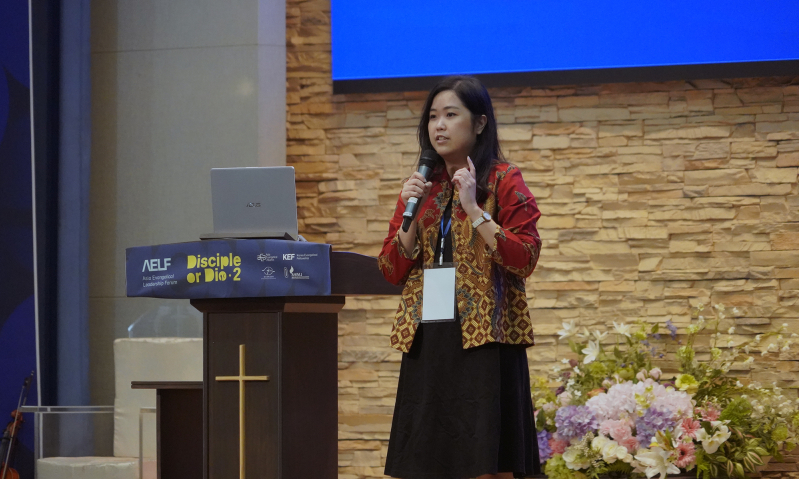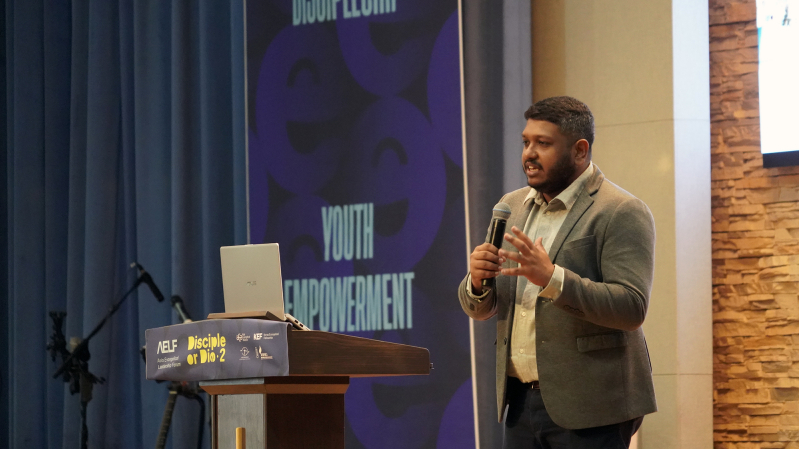
At the Asia Evangelical Leadership Forum (AELF) in Seoul this week, younger leaders outlined an ambitious strategy to mobilize and mentor a new generation of disciple-makers. As part of one of the four key thrusts of the forum—Youth Empowerment—two co-leaders presented their findings and vision to fellow delegates, arguing that young people are not only receptive to the gospel but are uniquely positioned to catalyze spiritual renewal in their communities.
The youth strategy group was led by Vania Christian of Indonesia and Jerome Yashodhan Rasiah of Sri Lanka, who serve as co-facilitators of the Youth Empowerment thrust. During their report, the two leaders made a strong case that Asia’s young people should be viewed not as a problem to be solved but as a solution already forming. They stated that young people, when properly discipled and empowered, are among the most effective agents for evangelism and spiritual multiplication—especially among their peers.
Christian began the presentation by emphasizing the importance of investing in youth, countering stereotypes that portray Gen Z as fragile or disengaged. “Many people say they are the generation of strawberries,” she said, referencing a common criticism that youth today are too soft or unstable.
Christian, however, emphasized their unique role in reaching their own generation and noted that many young Christians first encountered the gospel not through formal church programs but through friends, pointing to the strength of peer-to-peer influence in spiritual transformation.
The group’s core vision is simple: that one young person would disciple one other young person each year for the next ten years. While this one-to-one model might seem modest, the leaders argued that its cumulative potential is enormous.
Christian said their group had spent significant time discussing how to identify the most spiritually ready and committed young believers who could take on this challenge. They concluded that approximately 20 percent of youth in churches and ministries today could form a foundational core for the movement.
The criteria for this 20 percent included traits such as rootedness in spiritual community, consistent personal discipleship, evidence of biblical values and character transformation, a growth mindset, and active engagement in evangelism. Christian emphasized that this group does not need to be perfect, but must be committed to spiritual growth and the multiplication of faith. “We want to focus on those who are already living out the values we hope to spread—those who can become disciple-makers now, not in the distant future.”
However, the report did not ignore the significant challenges that stand in the way of such a movement. Christian acknowledged four major obstacles that emerged from their group discussions.
First, external life circumstances often interfere with discipleship—especially for young people from poor families, rural areas, or regions where early marriage and labor obligations prevent consistent participation in church life. Second, internal compromises such as spiritual inconsistency and a lack of personal discipline can hinder growth.
Third, the broader organizational culture in many churches does not currently support intentional discipleship, particularly for youth. Christian noted that some churches lack small-group structures or have few leaders trained in mentoring. Fourth, even where mentoring programs exist, the quality of mentorship is inconsistent. “Some young people have been placed in small groups, but their mentors themselves were never properly discipled,” she said.
Despite these barriers, both Christian and Rasiah expressed confidence that change is possible if church leaders across Asia are willing to adopt a long-term vision.

Rasiah described the strategy’s implementation using a three-part framework: head, heart, and hand. First, the “head” represents the intellectual and theological case for the movement, which the team hopes to make to pastors and alliance leaders. They want to convince leadership that multiplying discipleship is not simply another ministry option, but a core cultural shift necessary for the church’s future.
Second, the “heart” dimension involves storytelling and practical illustrations. Rasiah explained that the group had collected examples of churches already seeing exponential growth by empowering youth to disciple others. These testimonies, they believe, will help pastors move from intellectual assent to emotional buy-in.
Third, the “hand” portion involves developing tools and strategies that churches can use to implement the vision locally. These tools are still in development but may include resources for identifying emerging leaders, training mentors, and creating support structures within local churches.
Rasiah shared preliminary modeling that demonstrated the potential scale of the vision. He explained that if just 20 youth in each of 20 nations began discipling one new person per year, that would yield more than 100,000 disciples over eight years. Scaling up the base to 50 to 100 youth per country would result in as many as 500,000 young people being discipled over the same period. “Give us the 20 percent,” Rasiah told the forum attendees. “You give us the 20, and we will give you the 500,000.”
The youth strategy group is one of four strategic initiatives at this year’s AELF, alongside Children and Family Discipleship, Mission Mobilization and Acceleration, and AI Kingdom Deployment. Each group is tasked with drafting actionable proposals to be shared with national alliances, churches, and ministry networks throughout Asia.
For the youth strategy, Christian and Rasiah concluded by reiterating that Asia’s young people are ready and willing to take on a generational calling—if they are seen, trained, and released. “The best time to start is now,” said Christian. “It’s never too late. God can still use this generation for His glory.”





